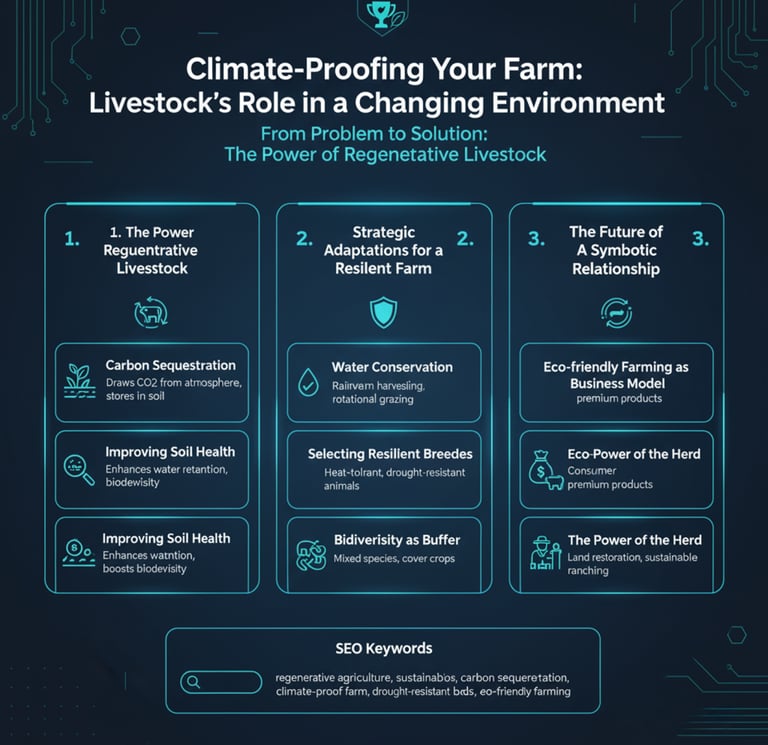Climate-Proofing Your Farm: Livestock's Role in a Changing Environment
For farmers and ranchers, the effects of climate change are not a distant threat—they are a daily reality. From unpredictable droughts and intense heat waves to altered growing seasons, a changing environment presents significant challenges to livestock farming. However, a growing number of producers are discovering that livestock are not just part of the problem; with the right approach, they can be a key part of the climate solution. By adopting strategic, eco-friendly farming practices, farmers can not only "climate-proof" their operations but also enhance the health of their land and boost profitability. From Problem to Solution: The Power of Regenerative Livestock Conventional farming often gets a bad rap for its environmental impact. But regenerative livestock farming flips this narrative. It's an approach that focuses on using animals as a tool to restore soil health, biodiversity, and ecosystem function. Carbon Sequestration Agriculture: One of the most powerful benefits of regenerative livestock is their ability to enhance carbon sequestration agriculture. When managed correctly through rotational grazing, livestock stimulate grass and plant growth. The deeper and healthier the plant roots, the more carbon they pull from the atmosphere and store in the soil. This process turns a farm into a carbon sink, actively working against climate change. Improving Soil Health: Hoof action from grazing animals breaks up soil crusts and works in organic matter, while their manure provides natural fertilizer. This improves the soil structure, increasing its ability to absorb and hold water, which is a critical defense against drought and flooding. Strategic Adaptations for a Resilient Farm Building a resilient farm requires more than just good grazing practices. It involves a holistic strategy that accounts for a new climate reality. Water Conservation: As water resources become more strained, smart management is crucial. This includes using gravity-fed water systems, rainwater harvesting, and rotational grazing to prevent overgrazing near water sources. Additionally, improving soil health through regenerative practices increases the land's natural ability to retain moisture, reducing the need for irrigation and mitigating the effects of drought. Selecting Resilient Breeds: Not all animals are created equal when it comes to climate resilience. Many farmers are turning to drought-resistant livestock and heat-tolerant breeds that are well-adapted to local conditions. For example, some heritage cattle breeds are better suited to foraging on tough pastures and can thrive with less supplemental feed than conventional breeds. Biodiversity as a Buffer: A monoculture farm is more susceptible to climate-related shocks. By integrating different types of livestock (e.g., cattle, sheep, and chickens) and planting diverse cover crops, farmers can create a more robust and resilient ecosystem. This biodiversity provides a natural buffer against pests, diseases, and extreme weather events. The Future of Farming: A Symbiotic Relationship The choice for farmers isn't between economic viability and environmental responsibility. The two are becoming increasingly intertwined. A farm that builds healthy soil, conserves water, and sequesters carbon is a farm that is better prepared to face the challenges of a changing climate. Eco-friendly Farming as a Business Model: Consumers are increasingly willing to support farms that prioritize sustainable ranching and environmental stewardship. This creates a market opportunity for producers who can transparently demonstrate their commitment to eco-friendly practices. The Power of the Herd: Ultimately, livestock, when managed thoughtfully, can be a powerful force for good. By embracing the principles of regenerative agriculture and viewing our animals as partners in land restoration, we can ensure that farming remains a viable and essential part of a sustainable future. The path to a climate-proof farm begins not with technology, but with a renewed appreciation for the symbiotic relationship between animals, land, and a changing environment.
Mr. Diyan Ahmed
9/26/20251 min read


Connect
Partnering for innovation across industries.
Explore
Discover
+923001534092
© 2025. All rights reserved.
